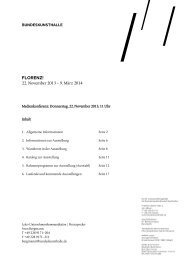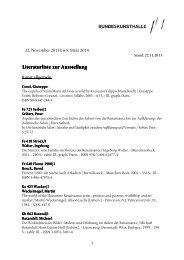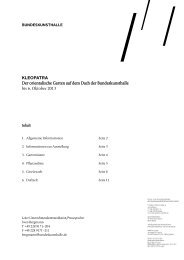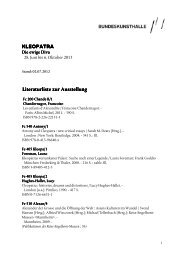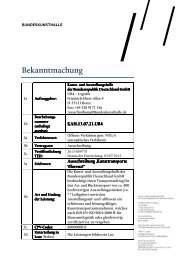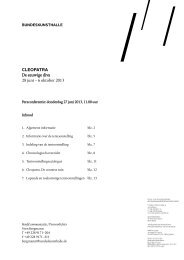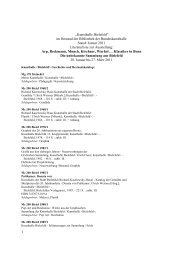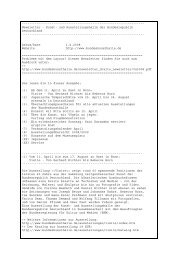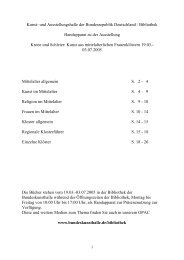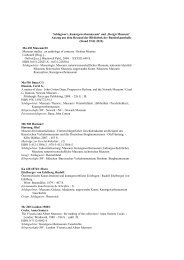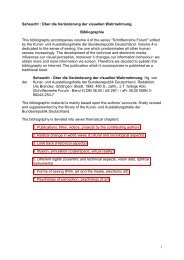Peoples through space and time Archaeology in Germany 09.05 ...
Peoples through space and time Archaeology in Germany 09.05 ...
Peoples through space and time Archaeology in Germany 09.05 ...
You also want an ePaper? Increase the reach of your titles
YUMPU automatically turns print PDFs into web optimized ePapers that Google loves.
Textile Rema<strong>in</strong>s Found <strong>in</strong> Settlements Built on Stilts<br />
The lakes, rivers <strong>and</strong> marshes of the Alp<strong>in</strong>e foothills are the most important sources of <strong>in</strong>formation on<br />
the economy, <strong>in</strong>terlac<strong>in</strong>g <strong>and</strong> weav<strong>in</strong>g work of the New Stone Age <strong>in</strong> Europe. Marshl<strong>and</strong>s <strong>and</strong> lake<br />
sediments provide the best conditions for preserv<strong>in</strong>g organic materials. As a result, settlements built on<br />
stilts offer the most comprehensive <strong>and</strong> diverse spectrum of such artifacts.<br />
Next to wooden tools, antler shafts, weave work from plant fibers for baskets, bags <strong>and</strong> mats, mostly<br />
complete articles of cloth<strong>in</strong>g have been found: <strong>in</strong>clud<strong>in</strong>g s<strong>and</strong>als, hats <strong>and</strong> cloak rema<strong>in</strong>s. The only other<br />
comparable f<strong>in</strong>d was the discovery of the mummified body of the Ötztal Iceman. Once the textile<br />
rema<strong>in</strong>s had been conserved <strong>and</strong> restored it was possible to reconstruct the village residents’ manner of<br />
cloth<strong>in</strong>g to the last detail.<br />
Underwater <strong>Archaeology</strong><br />
In the past years underwater archaeology has become <strong>in</strong>creas<strong>in</strong>gly important, <strong>in</strong> particular <strong>in</strong> the Baltic<br />
Sea region <strong>and</strong> at Lake Constance, where shipwrecks <strong>and</strong> submerged settlements are systematically<br />
be<strong>in</strong>g exam<strong>in</strong>ed by nautical archaeologists. In addition, excavations are be<strong>in</strong>g carried out <strong>in</strong> flat water,<br />
shorel<strong>in</strong>e zones <strong>and</strong> <strong>in</strong> marshl<strong>and</strong>s.<br />
Underwater conditions provide an excellent environment to preserve organic materials such as wood or<br />
textiles, which because of the possibilities of <strong>in</strong>terdiscipl<strong>in</strong>ary research, represent an overwhelm<strong>in</strong>g<br />
source of <strong>in</strong>formation.<br />
Dendrochronology - A Wooden Calendar<br />
Annual weather changes have an impact on tree growth <strong>in</strong> that they create tree r<strong>in</strong>gs <strong>in</strong> vary<strong>in</strong>g sizes,<br />
with different effects for different k<strong>in</strong>ds of wood <strong>and</strong> different places. The annual r<strong>in</strong>gs of wood<br />
specimens of various ages are compared, the data is transferred to a graph <strong>and</strong> brought <strong>in</strong>to<br />
chronological order. Absolute dat<strong>in</strong>g requires an unbroken series of annual r<strong>in</strong>gs up to the present.<br />
Because their r<strong>in</strong>gs are particularly pronounced, a tree r<strong>in</strong>g sequence was created for oak trees <strong>in</strong> Central<br />
<strong>and</strong> Western Europe - the preferred build<strong>in</strong>g material until the 18 th century.<br />
The chronology goes back to the first oaks appear<strong>in</strong>g <strong>in</strong> Central Europe approximately 10,000 years<br />
ago. Archaeologists have, for <strong>in</strong>stance, discovered that the New Stone Age existed for 3,300 years <strong>in</strong><br />
Central Europe (5500 - 2200 B.C.), which is twice as long than previously understood. Modern research<br />
goes beyond dat<strong>in</strong>g <strong>in</strong> that it provides important <strong>in</strong>formation on the development of climate <strong>and</strong><br />
environment over the past centuries.<br />
09<br />
The Bronze Age - The First Golden Age<br />
The Bronze Age (2300 - 800 B.C.) is an era characterized by major social, economic <strong>and</strong> technological<br />
development. Because of bronze metallurgy, various European regions that had previously almost no<br />
cultural contact to each other grew more closely together.<br />
Traffic <strong>and</strong> trade routes to ore deposits were established, specialized craftsmen were employed <strong>in</strong><br />
extract<strong>in</strong>g raw materials <strong>and</strong> <strong>in</strong> produc<strong>in</strong>g bronze objects. The flow of bronze goods over wide areas<br />
resulted <strong>in</strong> the establishment of foreign relations <strong>and</strong> fashion trends, <strong>and</strong> <strong>in</strong>spired the development of<br />
weapons <strong>and</strong> tools as well as the spread of religious ideas.<br />
Trade <strong>and</strong> Foreign Relations<br />
Numerous deposits of Early Bronze Age (2300 - 1500 B.C.) copper loop r<strong>in</strong>gs with a st<strong>and</strong>ardized<br />
weight found between the north of the Alps <strong>and</strong> the North <strong>and</strong> Baltic Sea coasts give testimony to the<br />
<strong>in</strong>tense trade <strong>in</strong> copper as a raw material. It was produced at Alp<strong>in</strong>e ore deposits <strong>and</strong> ultimately alloyed<br />
to make bronze by experienced metal workers.<br />
As of the Middle Bronze Age (1500 - 1300 B.C.), the <strong>in</strong>tercultural exchange of goods <strong>and</strong> ideas resulted<br />
<strong>in</strong> a dynamic process of social stratification <strong>through</strong>out society, while mak<strong>in</strong>g the material culture of<br />
various regions seem uniform.<br />
Ultimately, fortified hill settlements <strong>and</strong> other flatl<strong>and</strong> settlements protected by water which have been<br />
identified as centers of political, economic <strong>and</strong> religious life <strong>in</strong> the surround<strong>in</strong>g area make evident that<br />
the first establishment of territories <strong>in</strong> Central Europe began dur<strong>in</strong>g the Late Bronze Age (1300 - 800<br />
B.C.).<br />
11




